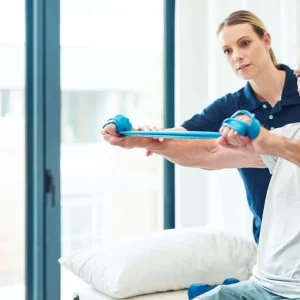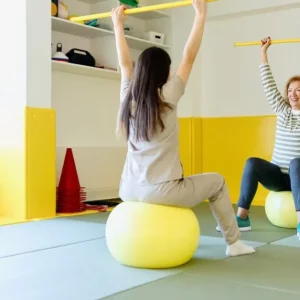Recovering from a stroke is a challenging journey that involves rebuilding physical strength, cognitive abilities, and emotional resilience. While physical therapy often takes center stage, consistently “working out” with brain exercises for stroke recovery is equally important.
These activities help stimulate neural pathways, increase neuroplasticity, promote cognitive recovery, and improve overall brain health. Today we will take a look at 12 practical brain exercises for stroke recovery that will help you to challenge your brain after stroke – plus you can do them from anywhere!
Jump to a section
Why Brain Exercises Matter for Stroke Recovery
Effective Brain Exercises for Stroke Recovery
Adding Brain Exercises to Your Stroke Recovery Routine
Why Brain Exercises Matter in Stroke Recovery
After a stroke, individuals may experience a number of physical, cognitive, and emotional effects. Depending on which areas of the brain sustained damage, individuals may have difficulties with memory, problem-solving, speech, emotional regulation, and/or motor skills.
This is where brain exercises matter and can be beneficial. Regular mental stimulation through brain exercises can:
- Stimulate Neuroplasticity: Encouraging the brain to form new pathways.
- Improve Cognitive Functions: Enhancing skills like attention, reasoning, and recall.
- Support Emotional Health: Fostering a sense of accomplishment and reducing frustration after stroke.
- Enhance Physical Recovery: Improving cognitive skills, such as attention and working memory, may also help boost participation and performance in physical rehabilitation.
With these benefits in mind, incorporating targeted brain exercises into your recovery plan is essential. Now, let’s explore 12 effective brain exercises after stroke that can help survivors.
Effective Brain Exercises for Stroke Recovery
1. Memory Games
Memory challenges are a common hurdle after a stroke, but engaging in memory-focused activities can help improve recall and cognitive processing. Simple games and exercises are a great way to start rebuilding these skills.
Some simple examples you can try out include:
- Matching card games.
- Memory puzzles.
- Apps like Lumosity or Elevate for interactive cognitive exercises.
To begin, focus on straightforward tasks, like matching two identical cards, and gradually increase the difficulty as your confidence grows. These activities are a great option for brain exercises after stroke that will not only strengthen short-term memory but may also improve focus and concentration.
2. Word Association Activities
Rebuilding language skills is essential for stroke recovery, especially for those facing aphasia or other speech difficulties. Word association exercises are a practical and engaging way to retrain language pathways.
A few ways you can use this activity:
- Pick a word, such as “summer,” and think of related terms like “sun,” “beach,” or “vacation.”
- Use word association apps or verbal games with a caregiver or family member for support.
- Try games such as Scattergories or Taboo, which can encourage language retrieval skills. Modify these by playing at your own pace with just one or two others in a distraction-free environment.
Word association activities can strengthen vocabulary, improve language recall, and foster verbal communication skills, making them a valuable tool for your recovery.
Pro tip: Start by practicing word association with common and familiar words, gradually moving to more abstract or less obvious associations as your confidence grows.
3. Simple Math Problems
Numerical reasoning can be affected after a stroke. However, practicing basic math exercises can help restore logical thinking and problem-solving abilities making them a great brain exercise for stroke survivors.
Examples
- Solve simple arithmetic problems, such as addition, subtraction, or multiplication.
- Engage with number-based puzzles like Sudoku or math-focused apps.
Begin with straightforward problems, using tools like a calculator for assistance if needed. As your skills improve, increase the complexity to challenge yourself. Stay consistent as regular practice will strengthen cognitive processing as well as rebuild confidence in handling everyday numerical tasks.
4. Jigsaw Puzzles
Jigsaw puzzles are an enjoyable way to enhance spatial awareness, hand-eye coordination, and concentration—key areas often impacted by a stroke. You should start with puzzles that have larger pieces and a simpler design, referring to a picture of the completed puzzle as needed. Then as you begin to feel more comfortable, progress to smaller pieces with more complex patterns.
The key is to choose puzzles that align with your current skill level and ask for assistance from family or caregivers if needed.
5. Drawing or Coloring
Creative exercises like drawing or coloring offer a calming and productive way to aid motor skill recovery and improve focus.
Basic Tips:
- Use coloring books with large, simple patterns.
- Try sketching basic shapes or tracing outlines for added variety.
Remember to focus on relaxing as you work and use tools that are easy to grip, such as larger crayons or pens. These activities not only enhance hand control and dexterity but also reduce stress, providing a therapeutic outlet during recovery.
6. Reading Aloud
Reading aloud engages the brain areas responsible for speech, auditory processing, and cognitive function, making it a vital tool for rebuilding language skills.
To begin, start with simple sentences or a children’s book with large print. Then, as your skills improve, progress to longer stories or articles. You can even pair this activity with audiobooks or read along with a caregiver to get feedback and support.
In terms of brain exercise after a stroke, this activity can improve articulation, rhythm, and confidence in verbal communication, which can help you feel more comfortable expressing yourself.
7. Naming Objects
Naming objects is a simple yet effective exercise for improving language recall and mental organization, making it ideal for stroke recovery.
Examples
- Identify items in your environment, such as “chair,” “lamp,” or “table.”
- Challenge yourself by describing each item’s function or characteristics.
Start with familiar objects and progress to less common items to keep the exercise stimulating. Consistent practice with this activity enhances word retrieval, improves mental clarity, and strengthens your confidence in verbal communication.
8. Listening to Music
Music therapy stimulates the brain in unique ways, making it a valuable tool for cognitive and emotional recovery.
Choose music that resonates with you. For a more well-rounded exercise, consider singing along, tapping your hand or foot to the beat, or even dancing (while seated or with assistance for safety if needed). You might also consider using stroke rehab tools like MusicGlove to combine rhythm with specific hand exercises. Engaging with music can help improve memory, reduce anxiety, and foster emotional well-being – all while stimulating multiple brain areas.
9. Meditation and Mindfulness
Mindfulness and meditation improve mental clarity, reduce stress, and rebuild focus, making them an excellent addition to stroke recovery. Some may also choose to combine mindfulness and meditation with yoga or a similar practice for enhanced physical benefits.
Create a quiet, distraction-free space to fully engage in mindfulness practice. Regular meditation can help improve attention, promote relaxation, and enhance emotional resilience, supporting your overall recovery.
10. Storytelling
Storytelling exercises engage memory, speech, and creativity, making them a well-rounded activity for cognitive recovery.
Examples to try:
- Retell a favorite story or share personal memories with loved ones.
- Create new stories using prompts or photographs for inspiration.
Work with a caregiver or loved one who can ask questions to guide your narrative. Storytelling can help strengthen memory recall, improve verbal expression, and foster a sense of connection and creativity.
11. Physical and Cognitive Dual-Tasking
Combining physical activity with cognitive tasks engages multiple brain regions, enhancing coordination and overall cognitive flexibility.
Examples
- Count your steps while walking around your home.
- Name categories of animals or objects while tossing a ball back and forth.
Incorporating tools like the FitMi Home Therapy System can help combine physical and cognitive tasks effectively. In addition, it provides a way to track your progress over time and see improvements.
This dual-tasking approach helps improve multitasking abilities, boost coordination, and enhance overall brain health, making it a powerful addition to your recovery plan.
12. Mental Practice and Motor Imagery
Using mental practice and motor imagery can enhance motor skills while also boosting attention and focus. When combined with conventional therapy, studies have shown that mentally visualizing yourself performing a task, such as raising your arm above your head, can improve performance.
If there is a specific movement or task you’ve been working on, practice visualizing yourself completing it successfully before actually trying. Over time, mental practice can help kickstart adaptive changes in the brain, leading to functional improvements.
Adding Brain Exercises to Your Stroke Recovery Routine
Stroke recovery requires patience, persistence, and the right tools. Incorporating these 12 brain exercises into your rehabilitation routine can help improve cognitive abilities, rebuild confidence, and enhance quality of life.
In addition, tools like FitMi and MusicGlove add a layer of engagement, making therapy not just effective but enjoyable.
Remember, recovery is a journey, and every small step brings you closer to regaining independence and well-being. Stay consistent, celebrate your milestones, and remain open to trying new approaches that make your journey both productive and rewarding.

















